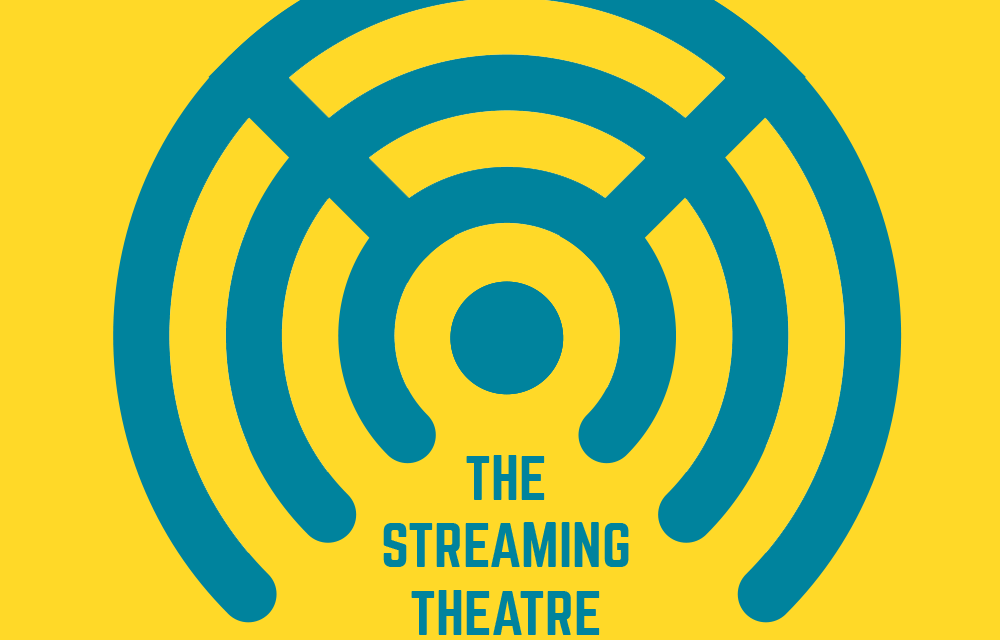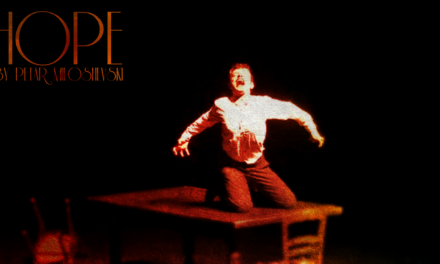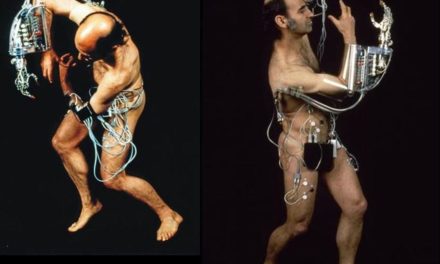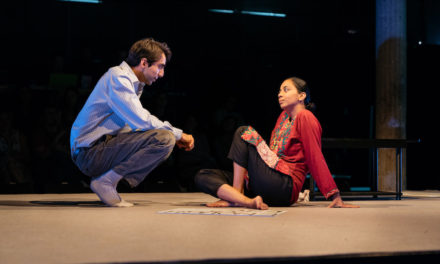As many have already said, the best streamed performances seem to be those that are made for the online venue. This is opposed to shows that originally debuted for live audiences and happened to get recorded, or for performances that had to be canceled due to the coronavirus and presented live over Zoom as a sort of consolation prize. But recently, I watched an unconventional production of Macbeth that embraced the limitations of online streaming wholeheartedly. A joint collaboration between two theatrical groups, Oddsocks and The Streaming Theatre, it made me rethink the potentials of online performance.
Several productions of Macbeth are online, so what makes this one special? The production seems barebones by most standards. The Scottish Play gets boiled down to a brisk 45 minutes and the three-person cast uses household props such as spoons and colanders for daggers and helmets. Yet the production proves more watchable than most others online, simply because it embraces the model of streamed entertainment. The family in quarantine acts out all the parts with a select number of cameras strewn around the house to capture the live feed, adding inventiveness. Live editing and effects then tie the scenes together, much like a live television show. The production debuted live on the Twitch streaming platform, where viewers could interact in a chat without disrupting the show. Currently, it’s available for viewing on YouTube.
But this is far from the only online production The Streaming Theatre has presented. Speaking with Kevin Kemp, the founder, and artistic director, I learned how the idea came about to highlight various theatre companies in a way that lent their talents to digital storytelling. Each partnership with a theatre assesses the ways in which they can produce a unique online experience. On July 11th, The Streaming Theatre will present an ambitious international production of The Tempest. Partnering with another new company, Globetrotting Shakespeare, the online platform will present The Tempest for Our Time, to benefit the Prague Shakespeare Company. While under normal circumstances a production between four different countries would prove difficult, once again streaming and editing should provide cohesiveness and accessibility.
In the wake of the Coronavirus, how did The Streaming Theatre start?
When the pandemic hit, and lockdown started, all of my friends and colleagues saw work dry up. Theatres closed, film production stopped and gigs for musicians had no open venues. I launched The Streaming Theatre because I wanted to make sure that the live arts could still have a place and a home while we live in this socially distanced world. I loved that theatres were releasing recordings of their old performances, actors were getting together on Zoom to read plays and that musicians were playing gigs from their bedrooms. But I knew we could do more. Artists thrive most when they collaborate and are connecting with their audiences in real-time. And for the audience, there is something so magical when they know that art is happening right at that moment. I have directed both theatre and film in my career, and love playing around with technology in art – and so I came up with the idea of taking conventions from theatre and combining them with video editing and filmmaking techniques to stream art live to audiences in real-time, but not just that, but to layer in multiple cameras for changes in angle, to add musical underscoring, sound effects, and even video effects to bring productions to the next level. I want to constantly push the technology to allow artists to not just survive, but to continue innovating and inspiring each other and connecting with their communities.
Why did you decide on Twitch specifically?
I have streamed to a number of different platforms but Twitch is by far my favorite–it’s purely a Livestream platform, so its interface is cleaner and lets you watch the show without all the packaging of the other streaming platforms. It’s more reminiscent of a TV channel. It’s mostly used by gamers to stream their gameplay but has recently seen more musicians, too, so I wanted to push that even further and offer live theatre and other kinds of art gigs. The other awesome benefit of Twitch is that because there isn’t really a large theatre presence on the platform at the moment, I am hoping we can attract new audiences to the art, and maybe even reimagine what theatre can look like.
The Streaming Theatre partners with other theatre companies. How do these partnerships come about?
Yes! We partner with theatre companies, individual artists, and we produce our own work, too. When I started The Streaming Theatre, there were a number of artists I knew I wanted to collaborate with, so I reached out to them and we created the first few shows. After that, directors I had worked with in the past got in touch and asked what we could do for their companies. And it took off from there! Most partnerships have come about through word of mouth so far, but I am really eager to work with new companies as well. There is a contact page on the website for anyone who wants to get in touch to collaborate on something. I have been directing some of the shows with a few companies, but I have also acted as Digital Director for others, where I help artists translate their work for online performance — so the way partnerships can look is very flexible!
I notice a few Shakespeare shows on the docket. Is this intentional, or to put it another way, how do you curate your “season?”
It has been quite serendipitous that there is lots of Shakespeare so far! It could be because it was coming up to the summertime when a lot of companies were gearing up to do outdoor Shakespeare. But I am really happy it has turned out that way, because I love the classics, and Shakespeare was actually the perfect way to explore this new medium.
Unlike with in-person shows, with this medium, you don’t benefit from all the conventions and environments that help you sink in to a performance. You don’t get the lights dimming, the instruments tuning up, anything like that. You could be at home with tons of distractions. It was really important to me for us to figure out how to recreate that sanctity of the live event. And I think that Shakespeare helped us through that. Shakespeare’s plays originally would have been performed in noisy outdoor spaces in the daylight, so the language and poetry are designed to work against distraction and help you focus on the art. So it was the perfect content to help us learn the conventions of this new medium – to figure out what we can do to let people fully engage with the live performance.
So with those tools in place, we are booking other pieces, too. I have a one-woman show coming up in July, a traditional storytelling night, more music gigs, and stand up comedy. When choosing what shows to produce, I ask myself: Is it something happening live – right in the moment for the audience? Is there something exciting we can do with it? And can we help the artist by airing it on the platform? Those are the most important things for me, and so far we have been able to adapt most pieces to make them work, which is a big part of the joy!
After watching Oddsocks’ Macbeth, I’m very curious. How did you do the live editing for the show?
Great question! To be honest it is a big mash-up of technology! For the camera feeds, because of lockdown, we just had to use what the family-run theatre company (Oddsocks) had on hand. So we ended up with eight different cameras all live at the same time, a combination of laptops, cell phones, and tablets set up around the house. We joined them all into a conference call and then window captured the feeds into an editing and streaming software. As the actors were performing, our editor watched all eight feeds, and switched to the right cameras as actors came into shot, dropped in video effects, changed camera angles, threw in sound effects, and anything else we needed. The editing was as much a part of the rehearsal process as the actors’ performances. On top of all the moving parts, we were also spread out around the world – the actors were in Derby, my editor was in Margate (both in the UK) and I was directing from California! It was pretty nerve-wracking – anything could have happened during the show. In fact, the actors told me after the stream that someone came to the door during the show, lucky they didn’t ring the doorbell!
You have an international production of The Tempest coming up. Any unique challenges to that or do you feel like prior shows have prepared you?
The Tempest has been a wonderful project to work on! One of the coolest parts of doing theatre online is that having an international production is so much easier than it would be in person! Actually the trickiest part of this show is the large cast and making everyone’s personal technology work with everyone else’s. Some actors have older laptops or tablets, so the way you fix a technical problem for one actor may not work for another! For example, with this production, we are playing around with digital backdrops and filters – and sometimes you find that an actor’s head has disappeared, or for some reason their hands are missing thanks to the green screen! But everything we’re doing at The Streaming Theatre is new – and so problem-solving and overcoming challenges is part of the fun! I love that aspect of the work! And every project helps me bring more tools to the next!
To what extent do you feel like the shows are made for streaming, as opposed to having a live audience?
It’s really interesting, because of course none of these plays were written with a streaming production in mind. But even when you do a show in person, the job of the actors and directors is to figure out how to communicate the content of the piece to the audience and how to get the audience to empathize with the piece. And you use things like stage movement and sound and lighting design to do that. And in a sense that’s exactly what we’re doing, too– we have to figure out how to use the features of this medium to communicate these pieces with the audience. We use different tools than an in-person production would, but our job is the same. The plays are the content and the theatre is a medium, The Streaming Theatre is just a different kind of venue.
Do you have plans to keep The Streaming Theatre going after quarantine?
Definitely! I think some things will change. Perhaps there will be some pieces that may return to the stage and leave the digital medium, but I am finding more and more that this really works as a performance space. I think that once theatres, concert halls, and bars reopen it will be so beautiful to experience art once again back in those venues. But digital storytelling and online art is here, and it offers artists opportunities that they would never have on stage and an interactiveness and intimacy that pre-recorded performances cannot.
For instance, we have found that people love to interact with the shows in the live chat! Which is great fun! If it is a play – then the actors tend to focus on the story. But musicians will react to the live chat and talk to the audience. We also had a film screening with a Q&A with the director which was great. We are finding that the platform is a really exciting way of allowing the audience to really feel involved. And when the performers take a bow at the end it is always lovely seeing the live chat explode with clapping hands, love hearts and smiley faces!
Lastly, anything else you’d like to share with us?
I think I would just love to say come and check us out! We have loads going on but the hardest thing to do is build audiences. We have had great turnouts – over 3,000 people tuned in to Macbeth. But for the artists to survive in this time they need people to watch their work! You can see our events pages on the website – www.thestreamingtheatre.com – if people like and follow us on social media that would be amazing (links on the website!)! If we can get people tuning in and watching we can commission more work and keep artists creating and connecting to their communities in this hardest of times. It is all about the audience. As artists we need you. So let’s stick together, even while we are apart!
This post was written by the author in their personal capacity.The opinions expressed in this article are the author’s own and do not reflect the view of The Theatre Times, their staff or collaborators.
This post was written by Andrew Agress.
The views expressed here belong to the author and do not necessarily reflect our views and opinions.


















